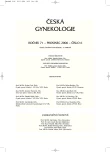Glandular Premalignant Lesions of the Uterine Cervix
Authors:
J. Sláma; P. Freitag; D. Cibula; D. Fischerová; M. Janoušek; D. Pavlišta; M. Strunová; Michal Zikán; N. Jančárková
Authors‘ workplace:
Gynekologicko-porodnická klinika VFN a 1. LF UK, Praha, přednosta prof. MUDr. A. Martan, DrSc.
Published in:
Ceska Gynekol 2006; 71(6): 446-450
Category:
Original Article
Overview
Objective:
Review of diagnostical and therapeutical methods in glandular premalignant lesions of the uterine cervix.
Design:
Review article.
Setting:
Department of Obstetrics and Gyneacology, 1st Medical Faculty, Charles University and General Faculty Hospital, Prague.
Results:
The incidence of invasive adenocarcinomas of the uterine cervix is increasing. Incidence ratio between adenocarcinomas and spinocellular carcinomas is approximately 1:5; however ratio of premalignant lesions reaches only about 1:80. Glandular premalignant disease is usually found in the specimen taken for squamous disease. The coincidence of both types of premalignant lesions, so called „mixed lesion“, is revealed in about 46–72 %. PAP-smear of AGC-NOS/-NEO or adenocarcinoma in situ (AIS) in combination with typical colposcopic appearance raise a suspicion of glandular lesion. Direct biopsy must be always performed to get definite diagnosis. Optimum biopsy technique requires cylindrical excision. A woman can be carefully followed if desires pregnancy and specimen margins are negative. Hysterectomy is indicated if reproductive plans are completed.
Conclusion:
Diagnosis of glandular premalignat lesion of the uterine cervix is more complicated in comparison to spinocellular one, however it is getting more significant due to increasing incidence. Colposcopy and cytology are less reliable. Any suspicion on glandular premalignat leasion requires more active approach and radical procedure (hysterectomy) if possible.
Key words:
adenocarcinoma in situ, uterine cervix, premalignant lesions, colposcopy, PAP-smear
Labels
Paediatric gynaecology Gynaecology and obstetrics Reproduction medicineArticle was published in
Czech Gynaecology

2006 Issue 6
Most read in this issue
- Clinical Comparison of Laparoscopy-Assisted Vaginal Hysterectomy (LAVH) and Total Laparoscopy Hysterectomy (TLH) in Women with Benign Disease of Uterus – a Prospective Randomized Study
- Hormonal Contraception Possible Interactions
- Placenta and Annexin V Receptors, Antibodies against Annexin V and against Other Phospholipids in Patients with Recurrent Pregnancy Loss
- The Impact of Total Abdominal and Laparoscopically Assisted Vaginal Hysterectomy on the Development of Urine Incontinence
